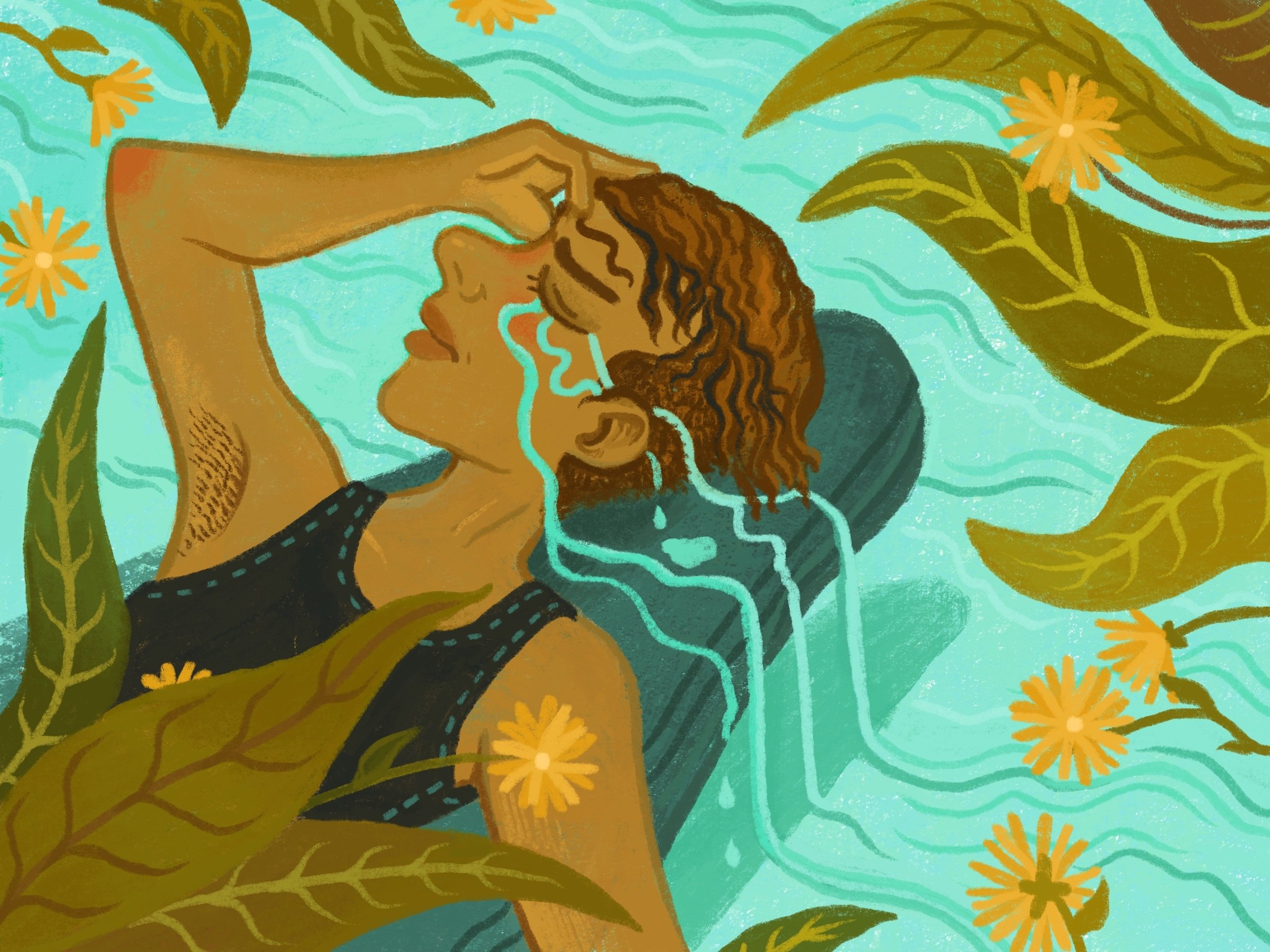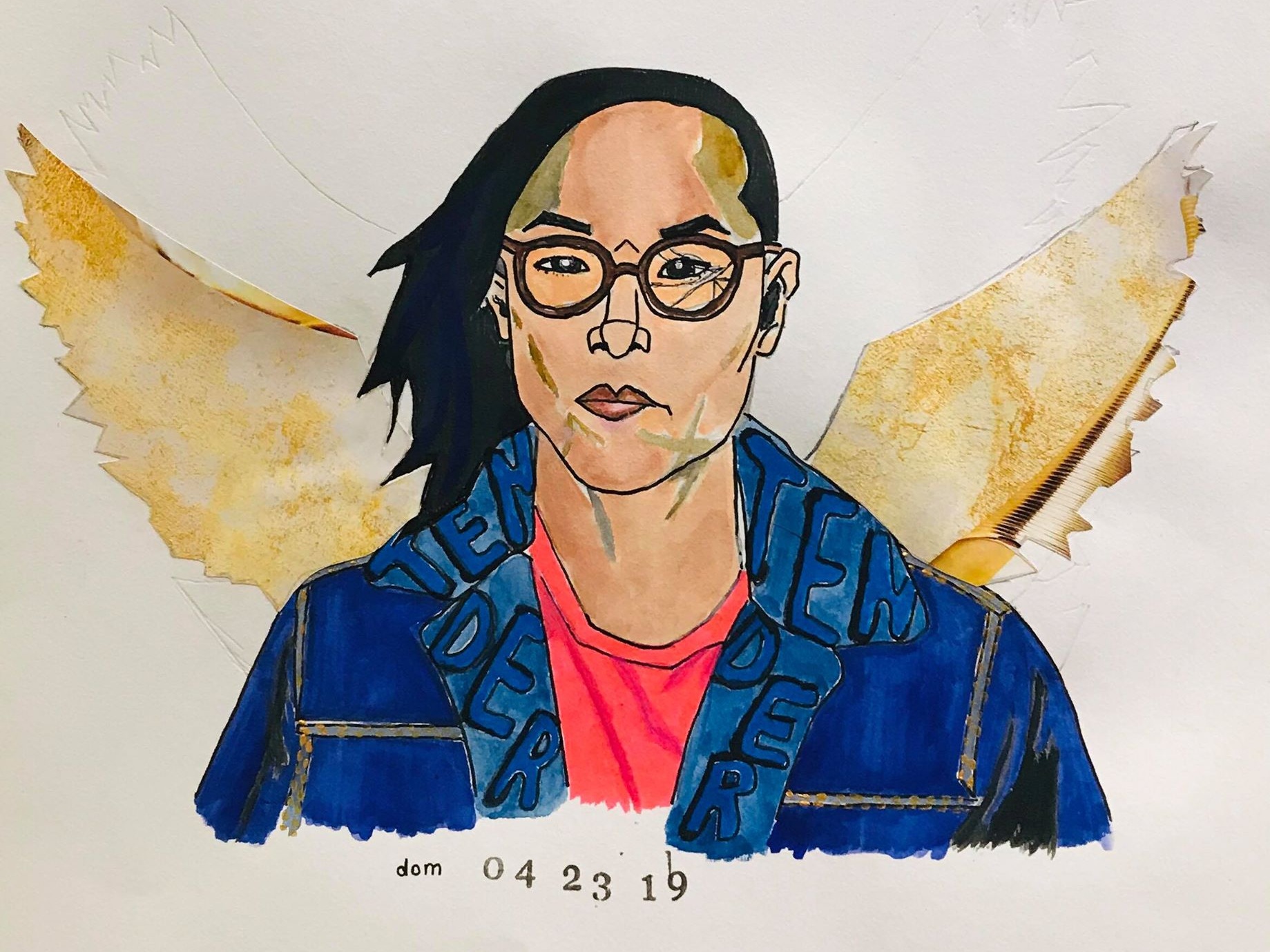Art by Asharah Saraswati
CN: sexual violence, abuse
In many methods of healing from trauma, confronting shame is often central to the process. Free up shame, get out from under the blame placed on survivors, and healing is supposed to get easier. Yet when survivor’s guilt goes unaddressed, it’s easy to fall into the pattern of prioritizing other people’s needs over individual needs. Survivors deserve the support required to move through the wake of guilt and towards deeper healing.
You deserve to heal.
I deserve to heal.
Healing justice means we ALL deserve to heal. And it’s necessary because we live in a world where few people get to center their wellbeing and thrive.
Forms of Survivor’s Guilt
The term “survivor” often refers to survivors of sexual violence, and I am writing this from that perspective. But the same guilt manifests in other situations too, and that’s important to name in order to address larger patterns of victim-blaming in society.
Survivor’s guilt can also occur when someone who has experienced financial hardship has an increase in resource availability, when a person who’s been in abusive partner relationships finds a relationship with a healthier dynamic, and when anyone breaks through a glass ceiling or barrier to success that was put in place by oppressive forces. If you feel bad about having your basic needs met, that is survivor’s guilt. These emotions crop up because survivors understand first-hand that not everyone has access to safety and security.
Processing trauma involves a litany of what-if questions: What if that had never happened? What if there had been more support available to me before? What if the violence succeeded in taking a life? What if I was still in that place, and what of others who are still in similar situations? That’s just the start of naming and healing from trauma, and without support, it’s easy for survivors to stay stuck in that phase of processing, held down by the resulting guilt.
Being the Survivor Who Speaks Out
The more I name the ways that societal violence led me to survive interpersonal violence, the less shame I carry for being in those situations. Until I can create a narrative that connects all the pieces, the only person I’m blaming is myself.
For example, when I was laid off from a full-time job in college and, I wound up living in a monogamous relationship with a man twice my age to avoid homelessness. I blamed myself for years until I realized that he coerced me, knew it wasn’t what I wanted, and refused to support me as a friend. Even though he knew I had just left another abusive relationship and was looking for queer connection, he insisted that to get support, I be his significant other. If I wanted a place to live, I had to do what he said. Poverty and the lack of a supportive family led to me making decisions that I didn’t want to make, decisions that ultimately caused harm to me. Naming these dynamics hasn’t ended the pain, but it has helped me to begin healing by forgiving myself.
Yet as quick as my shame dissipates, it’s replaced with guilt. Survivor’s guilt is the icky feeling that I don’t deserve to still be alive, don’t deserve to be wherever I’m at in my healing process, and don’t deserve the voice I’ve found to break the silencing and speak out against cycles of violence.
I know few get the opportunity to heal. That’s the motivation that drives me to do healing justice work. But in offering community support, I often forget that I’m part of the community too, that I deserve access to heal from trauma. And those “I don’t deserve _____s” are all giving voice to my survivor’s guilt, creating anxiety and disrupting my healing process.
My Healing is Connected to Your Healing
As a survivor of multiple forms of violence, my healing process will not and cannot be complete until these cycles of violence are ended at large. Therefore, I’m not individually responsible for figuring out how to no longer feel survivor’s guilt; society is responsible for ending the violent conditions that lead to the creation of survivor’s guilt.
This emphasis on collective healing does not mean I can’t achieve great milestones in my personal recovery, such as having mutually supportive relationships, feeling safe and at home in my body, ending patterns of avoidance, and simply experiencing fewer flashbacks – all goals I’m currently working toward. However, it does mean that my individual healing and wellbeing are tied to collective healing and wellbeing.
Even if I – when I – am able to get to a place in which I am not impacted by echoes of violence on a daily basis, my personal healing can be disrupted by knowledge of ongoing violence in the world at large. I feel this alongside other rape survivors whenever there is a public conversation about sexual violence, especially when witnessing the outrageous lack of accountability. There are times these public discussions don’t set off flashbacks that force me to recall specifics of what I’ve survived, and yet I am still impacted by the reminder of how widespread sexual violence is. Maybe I don’t get to the flashbacks because that alone is enough to dissociate, to distract myself, to get away from that whole line of thinking.
I don’t need to be in touch with my own wounds to lose a day of productivity to these emotions. Some of this impact is the result of secondary trauma, knowing the stories and witnessing the distress of other survivors. But some of these feelings aren’t connected to any specific story – they’re a result of acknowledging how many stories there are, as well as how frequently the individuals in these stories of violence are silenced, blamed, and abandoned.
Moving Through Survivor’s Guilt
Since healing is not linear, there is not one path to process trauma and move through the thoughts and feelings necessary to heal. We’re all on our own path, and I’d like to share a turning point in mine.
On my first ever meditation retreat, three days of silence in queer community, I knew that I would cry a lot. I knew that I would struggle to sit with trauma, the emotional flashbacks, and also the guilt of being in a place to heal. What I couldn’t prepare for was a beautiful forgiveness meditation led by a trans Dharma teacher La Sarmiento (available here).
Until that moment, I didn’t realize how much self-blame I was still holding, and I was jolted out of it by this gift from a compassionate teacher. After that, I snuck off to lay on this big rock by a river in the woods nearby, and I cried for an hour. As I felt the sun and the wind on my skin, I felt cleansed by nature, returning to a more natural state of myself that exists without these heavy emotional weights. This is a moment I think back to often as I let go of more and more false beliefs and perceptions that create the shame and guilt lingering within me.
The end goal of my individual healing process is to be able to remember trauma stories without turning any of the difficult feelings inward on myself, to learn to release that energy instead like I did on the rock by the river and make space for new emotions and experiences.
I would like to see my survivor’s guilt replaced with self-love, with understanding, and with hope that by confronting trauma in my life, my own healing can have a small impact on the ways trauma is confronted in society at large. Ultimately, I hope we can live in a world where victims are never blamed, where everyone who undergoes violence (in any role) has support to grow, and where there is absolutely no shame in surviving and healing.
A Healing Journey in 4 Steps
1. Notice how guilt and self-blame impact your thoughts, feelings, and beliefs about yourself. It's not your responsibility to carry this much pain.
2. Name the ways that societal violence led to surviving interpersonal violence. What you're healing from is not your fault.
3. Look at how your individual healing and wellbeing are tied to collective healing and wellbeing. You aren't healing alone; you’re healing with the community here at Rest for Resistance right now.
4. Healing will continue to happen, even when recovery feels impossible. The goal is not to be "ok," but to be able to remember trauma stories without turning any of the difficult feelings inward on yourself. This makes space to see yourself in your life story with greater self-love, confidence, and pride.
This essay was originally published on The Body is Not an Apology. Head there to read more work from Dom Chatterjee, including “3 Ways to Manage PTSD When It Feels like It’s Managing You” and “Independence is an Ableist Myth: Unlocking the Power of Community in Healing.”
We need community support to continue publishing!
Articles and artwork like these are only possible through your contributions. Please donate today to sustain the wellbeing of artists, writers, healers, and LGBTQ2IA+ people of color.
You can also sustain our team of disabled queer & trans creatives of color by pledging on Patreon or making a one-time donation.
Image description: A brown-skinned person with short hair is illustrated laying on a flat rock, next to a river. Tears stream down their face as they hold one hand to their forehead. Green leaves and yellow flowers are growing out over the water.
About Asharah Saraswati:
Asharah Saraswati is an illustrator based out of Southern California, currently creating comics and apparel – including the limited-time “Respect Trans Bodies” tee co-designed with Dom Chatterjee. Check out Asharah’s sketchbook at art-twink.tumblr.com, and follow Art Twink on Instagram and facebook.
About Dom Chatterjee:
Dom Chatterjee is the founder of QTPoC Mental Health and Rest for Resistance. They are a freelance editor, self-taught designer, cat lover, and meditation teacher who is working to decolonize yoga and Buddhism in the US.










